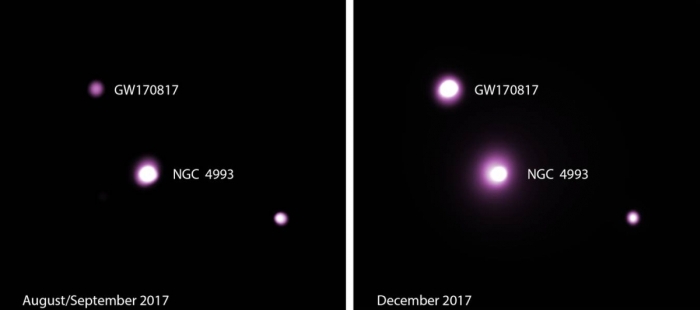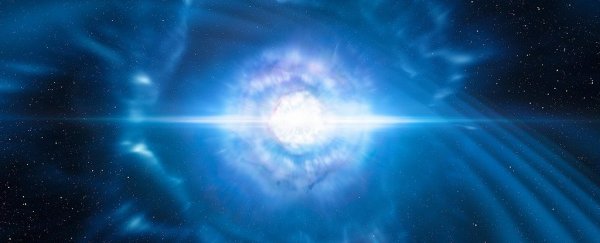When something explodes, you expect there to be a bright flash that subsides.
This is what astrophysicists thought would happen when they observed the collision between two neutron stars last August - but contrary to expectations, it's still continuing to brighten months after the event, leaving scientists stunned.
According to data from NASA's Chandra X-Ray observatory, the aftermath of that collision is much more complex and interesting than anyone ever expected.
We'd never before directly observed a collision between two neutron stars. It was only thanks to the new field of gravitational wave astronomy detecting ripples in the very fabric of space-time that astronomers around the world were able to point their instruments at the event later named GW170817 on 17 August last year.
The spectacular merger happened 138 million light-years from the Solar System.
And we learned a lot - for example, collisions between neutron stars really do produce gamma-ray bursts, some of the brightest and most energetic events in the universe. This confirmed a long-held hypothesis about one origin of these spectacles.
The gamma-ray burst was named GRB170817A, and it was expected it would fade relatively quickly - but that's not what happened.
Two days after the collision, no optical source was visible - so far, so normal. But at nine days post-collision, Chandra data revealed a new X-ray source at the location of the burst.
"Usually when we see a short gamma-ray burst, the jet emission generated gets bright for a short time as it smashes into the surrounding medium – then fades as the system stops injecting energy into the outflow," explained astrophysicist Daryl Haggard of McGill University, whose research group led the new study.
"This one is different; it's definitely not a simple, plain-Jane narrow jet."
 (McGill University)
(McGill University)
After 16 days post-collision, the object's position in the sky was too close to the Sun for sensitive X-ray measurements to be taken for some time. It wasn't until 109 days had passed - early December 2017 - that astronomers could renew their data-gathering.
As soon as they were able, the research team took X-ray readings of GRB170817A - and those December measurements were brighter than those taken in early September. These were consistent with the radio data, which also showed an increase in brightness at the same rate.
This brightness can be explained if the collision was a bit more complicated than initially thought, the researchers say.
One potential cause would be if the collision between the neutron stars created a jet or outflow, which in turn shock-heated the material surrounding the new object created by the collision (possibly a black hole).
This could then glow in the X-ray and radio spectra for months following the event. The X-ray light curve matches predictions for this hypothesis, although the origin of the outflow is still uncertain.
Now astronomers are trying to figure out what the cause actually is - and the physics behind it. Further monitoring from Chandra will help either validate or disprove the outflow model.
"This neutron-star merger is unlike anything we've seen before," said co-author Melania Nynka, also a postdoctoral researcher at McGill.
"For astrophysicists, it's a gift that seems to keep on giving."
GW170817 may have made a mark on history, but it's far from done. It will continue to be one of the most-studied objects in the sky for some time to come.
The team's research has been published in the Astrophysical Journal Letters.
